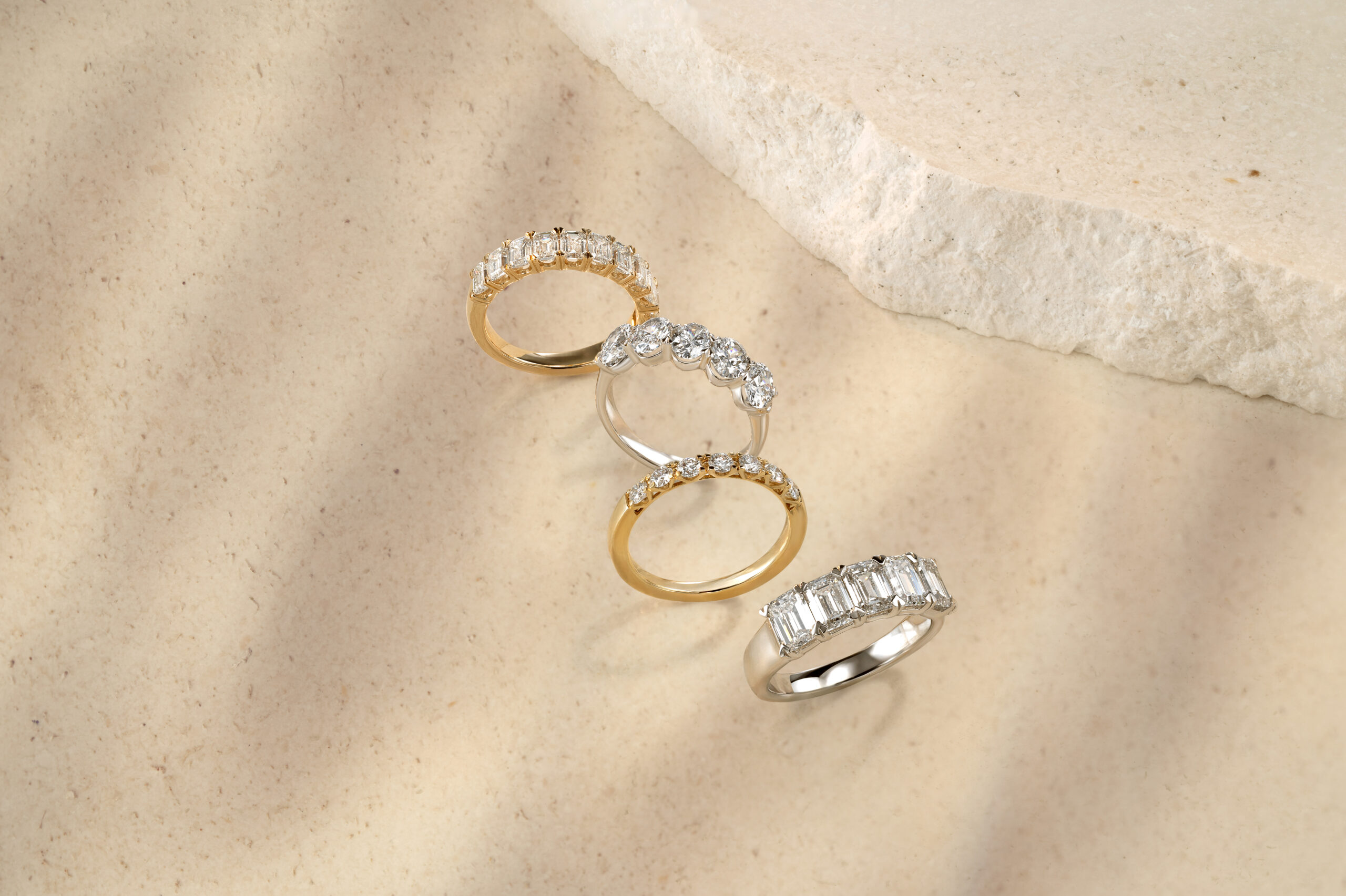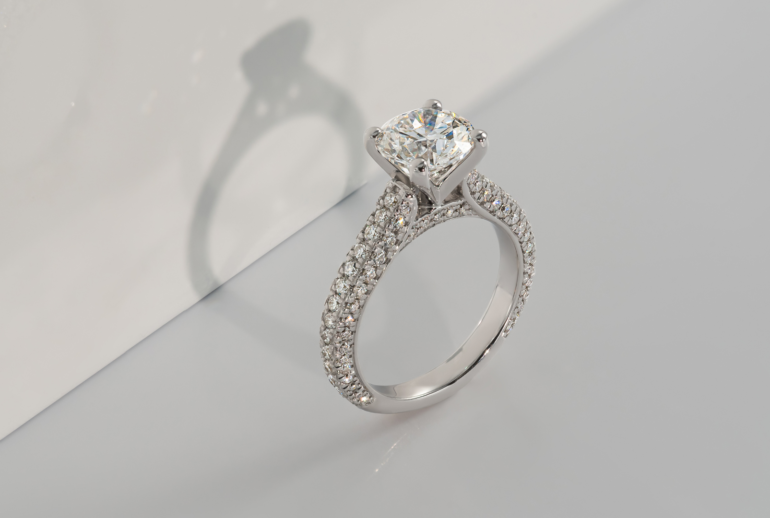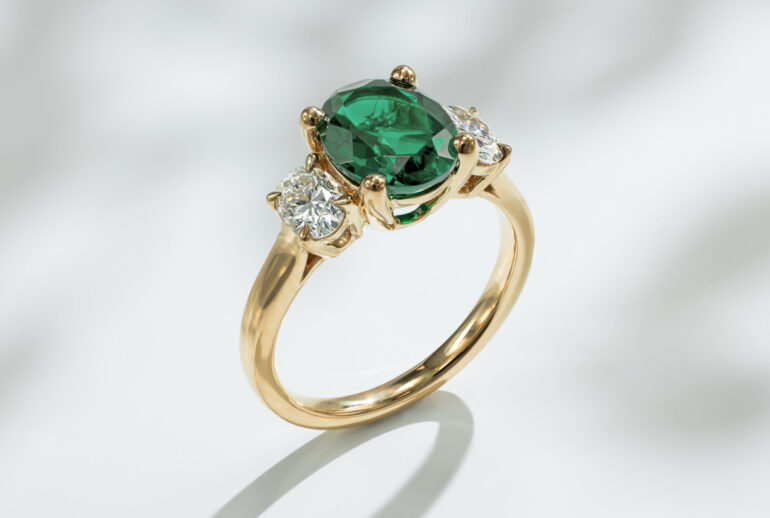Wedding bands are symbols of commitment and love between couples. They are a constant reminder of the vows made on the wedding day and are worn every day, so selecting a durable and beautiful piece of jewelry that will last a lifetime is critical.
While natural diamonds have been the traditional choice for wedding bands, the rise of lab created diamonds has given couples a more ethical and sustainable option.
How are Lab Grown Diamonds Made?
Lab created diamonds are grown in a controlled laboratory environment, replicating the natural process of diamond formation. They are fabricated using high-pressure high-temperature (HPHT) or chemical vapor deposition (CVD).
During the CVD method, a small diamond seed is placed in a chamber filled with carbon-rich gas, then heated to high temperatures. As the gas molecules break down, the carbon atoms are deposited onto the diamond seed, gradually growing into a diamond crystal.
In the HPHT method, a tiny diamond seed is placed in a press and subjected to high temperature and pressure. This causes carbon atoms to be forced onto the diamond seed, leading to crystal growth.
Because of the precision manufacturing process, lab grown diamonds typically have fewer defects and inclusions. This makes them more durable and structurally sound than natural diamonds and less likely to shatter, shear or break.
What are the Benefits of a Lab Grown Diamond Wedding Ring?
Lab grown diamonds are real diamonds. They have the same physical, optical and chemical composition and are identical to natural diamonds. This means you can get a stunning, sparkling gemstone with identical properties as a natural diamond but at a fraction of the cost.
Other benefits of choosing a lab grown diamond include:
- Affordability: Lab grown diamonds are more affordable than natural diamonds of similar size and quality. This means you can buy a lab grown diamond with a higher carat value on a budget with the same optical and chemical properties as a natural diamond without sacrificing quality or beauty.
- Availability: Lab created diamonds are produced in as little as a few weeks, compared to natural diamonds, which take billions of years. And because lab grown diamonds are not a finite resource, there is always a consistent supply and numerous cuts and carat weights.
- Ethical: Unlike natural diamonds, which may be associated with human rights violations, man-made diamonds are free from any ethical concerns since they are made in a controlled laboratory setting. The lab technicians who create lab grown diamonds are paid a fair wage and facilities and employers meet all local labor laws.
- More Beautiful: The process of creating diamonds is carefully controlled, so lab grown gems often have fewer inclusions and defects, making them appear bigger, brighter and purer.
- Greater Variety: Colored diamonds, such as pink or yellow stones, are in high demand; however, they are typically more expensive than white diamonds due to their rarity. In the lab, rare colors and those not often found in nature are easily recreated, allowing you to design a one-of-a-kind wedding ring.
Precious Metal Wedding Bands
Precious metals commonly used in wedding bands, such as gold, platinum and titanium, are known for their strength and durability. They are resistant to bending, warping and breaking, making them an excellent choice for a wedding band that will be worn daily. They are also resistant to tarnish and corrosion, so they will maintain their luster and shine for years.
Gold
Gold is a classic choice for wedding bands, available in various hues like yellow, white and rose gold. Yellow gold provides a warm, traditional appearance, while white gold offers a modern, sleek look. Rose gold wedding bands have gained popularity due to their romantic, distinctive color, resulting from the combination of gold and copper.
Gold is malleable, allowing for intricate designs and customization. However, its softness requires periodic maintenance and possible re-plating for white gold wedding bands to maintain their luster.
Platinum
Platinum is naturally white and does not tarnish or fade over time, requiring less maintenance than gold. Its hypoallergenic properties make it an excellent choice for those with sensitive skin.
Although platinum is more expensive than gold, its durability and timeless elegance make it a worthwhile investment.
Choosing the Right Fit
When finding the right fit for your wedding band, there are a few steps you can take to ensure your ring is comfortable, secure and fits your style. Getting an accurate measurement for your wedding band is important. It ensures a comfortable fit and prevents the ring from slipping off or being too tight.
The size of a ring is typically represented by a number, which corresponds to the circumference of the finger in millimeters. The average ring size for women in the U.S. is 6, but common measurements range from 4½ to 7½. Sizes can vary depending on brand, designer or location. You can measure your ring size with a ring sizer tool or use a printable ring sizer online.
Once you have your size, consider the width and thickness of the band. If you choose a wide band, you may need a larger size to fit comfortably, while a thinner band may need a smaller size to prevent slipping. Try on different styles and metals to find the one that feels right for you.
At Grown Brilliance, we offer a free ring resizing within 30 days of purchase to ensure your piece fits perfectly. Simply ship us the ring, and we’ll resize it and ship it back. We also offer one free resizing per year for the lifetime of your ring as part of our commitment to guaranteeing your piece provides a comfortable fit for years to come.
Caring for Your Wedding Band
Your wedding band is more than just a piece of jewelry; it symbolizes your love and commitment. Taking good care of it will ensure it lasts a lifetime. Use the following tips to keep your engagement ring and wedding band in excellent condition:
- 1. Remove your wedding band before engaging in activities that might scratch or damage it, such as sports, swimming or household cleaning.
- 2. Avoid exposing your wedding band to harsh chemicals and abrasives. Keep it away from compounds like chlorine and ammonia and limit exposure to acids from vinegar and lemon juice.
- 3. Store your wedding band separately from other jewelry to prevent scratches. For example, keep your rings in a velvet-lined compartment in a jewelry box when you take them off.
- 4. For gold or platinum wedding bands, put the items in a mixture of water and mild soap or specialized jewelry cleaner. Let the rings sit for about 20 minutes, then gently scrub them with a soft-bristled toothbrush. Rinse your rings under warm water and dry them with a soft cloth made of cotton or microfiber material.
Find the Perfect Ring With Grown Brilliance
Grown Brilliance is committed to providing our customers with high-quality, ethically sourced lab grown diamonds. Our jewelry is not just about beautiful designs and exceptional craftsmanship but also about positively impacting society and the environment.
Discover our collection of conflict-free, environmentally responsible gold and platinum wedding bands for women. Whether you are searching for the perfect engagement ring or unique diamond jewelry to add to your collection, our commitment to quality, ethics and customer satisfaction ensures you’ll find the ideal piece for your needs.



